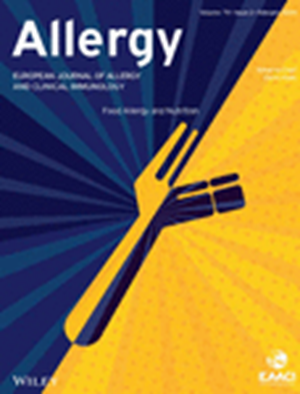The Prevalence of Symptomatic Dermographism: Results of the International UCARE PREVALENCE-D Study.
IF 12
1区 医学
Q1 ALLERGY
引用次数: 0
Abstract
BACKGROUND The prevalence of symptomatic dermographism (SD) in the general population remains unclear. This study aimed to internationally estimate the prevalence of SD and two other dermographic subtypes-physiological red dermographism and simple urticarial dermographism-among adults worldwide. METHODS The PREVALENCE-D (Prevalence Estimation of Dermographism) study was the largest international, cross-sectional, internet-based investigation conducted by the Urticaria Centers of Reference and Excellence of the Global Allergy and Asthma Excellence Network from 2021 to 2024. A world expert-designed questionnaire was completed by participants from 28 centers across 19 countries to diagnose SD. Participants were recruited into three age groups (18-24, 25-60, and > 60 years), with ≥ 1000 individuals per group per country. We calculated sex- and age-adjusted prevalence estimates internationally and by country, with 95% confidence intervals. RESULTS Among 59,543 participants worldwide, those with SD had an adjusted point prevalence of 3.20% (95% confidence interval [CI] 2.68%-3.73%) and a lifetime prevalence of 5.94% (95% CI 5.32%-6.56%). The 25-60 years group presented the highest prevalence. Females had higher rates than males, with statistically significant differences across all age groups for both point and lifetime prevalence. Physiological red dermographism had an adjusted point prevalence of 10.02% (95% CI 9.48%-10.55%) and a lifetime prevalence of 33.47% (95% CI 32.01%-34.94%). Simple urticarial dermographism showed an adjusted point prevalence of 1.21% (95% CI 1.08%-1.35%) and a lifetime prevalence of 5.39% (95% CI 4.99%-5.79%). CONCLUSION These findings provide comprehensive international estimates of dermographism, particularly SD, and emphasize the need for appropriate healthcare resource allocation and disease recognition.症状性人口统计学的患病率:国际UCARE患病率研究的结果。
背景:症状性人口统计学(SD)在普通人群中的患病率尚不清楚。本研究的目的是在全球范围内估计SD和其他两种人口统计学亚型(生理性红色人口统计学和单纯荨麻疹人口统计学)在成年人中的患病率。方法患病率- d(流行病学估计)研究是由全球过敏和哮喘卓越网络的荨麻疹参考和卓越中心于2021年至2024年进行的最大的国际,横断面,基于互联网的调查。来自19个国家28个中心的参与者完成了一份世界专家设计的问卷,以诊断SD。参与者被招募到三个年龄组(18-24岁、25-60岁和60岁以下),每个国家每组≥1000人。我们计算了国际上和国家按性别和年龄调整的患病率估计值,置信区间为95%。结果在全球59,543名参与者中,SD患者的调整点患病率为3.20%(95%可信区间[CI] 2.68%-3.73%),终生患病率为5.94% (95% CI 5.32%-6.56%)。25-60岁年龄组患病率最高。女性的发病率高于男性,在所有年龄组的时点和终生患病率上都有统计学上的显著差异。生理性红色人口统计学校正点患病率为10.02% (95% CI 9.48% ~ 10.55%),终生患病率为33.47% (95% CI 32.01% ~ 34.94%)。单纯荨麻疹人口统计显示调整后的点患病率为1.21% (95% CI 1.08% ~ 1.35%),终生患病率为5.39% (95% CI 4.99% ~ 5.79%)。结论这些发现提供了全面的国际人口统计估计,特别是SD,并强调了适当的医疗资源分配和疾病识别的必要性。
本文章由计算机程序翻译,如有差异,请以英文原文为准。
求助全文
约1分钟内获得全文
求助全文
来源期刊

Allergy
医学-过敏
CiteScore
26.10
自引率
9.70%
发文量
393
审稿时长
2 months
期刊介绍:
Allergy is an international and multidisciplinary journal that aims to advance, impact, and communicate all aspects of the discipline of Allergy/Immunology. It publishes original articles, reviews, position papers, guidelines, editorials, news and commentaries, letters to the editors, and correspondences. The journal accepts articles based on their scientific merit and quality.
Allergy seeks to maintain contact between basic and clinical Allergy/Immunology and encourages contributions from contributors and readers from all countries. In addition to its publication, Allergy also provides abstracting and indexing information. Some of the databases that include Allergy abstracts are Abstracts on Hygiene & Communicable Disease, Academic Search Alumni Edition, AgBiotech News & Information, AGRICOLA Database, Biological Abstracts, PubMed Dietary Supplement Subset, and Global Health, among others.
 求助内容:
求助内容: 应助结果提醒方式:
应助结果提醒方式:


